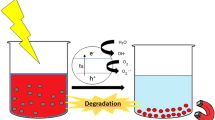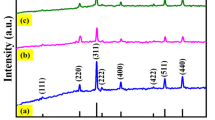Abstract
An electrochemical quartz crystal nanobalance has been used to study the redox behavior of poly(copper phthalocyanine) (poly(CuPc)) microparticles attached to gold. The electrodes were investigated in contact with aqueous solutions at different pH values. In acid solutions, in the pH range from 0 to 3, one pair of reduction and reoxidation waves can be detected in the potential region from 0.8 V vs. SCE to the beginning of the hydrogen evolution. Until 0.8 V, no oxidation of the poly(CuPc) sample occurs. The reduction is accompanied with a mass increase; the original mass of the surface layer is regained during reoxidation. Below pH 0, two pairs of waves appear attesting the formation of the doubly protonated poly(CuPc). A ca. −60 mV/pH dependence of the peak potentials indicates the participation of H+ ions in the redox reactions in an 1 H+/1 e− ratio in acidic and neutral solutions and the formation of 1 OH− ion/1 e− in basic electrolytes. In neutral and alkaline solutions, however, the mass changes become more complicated. In alkaline media, during electroreduction, a mass decrease occurs in the beginning of the reduction which is followed by a mass increase. In the course of reoxidation, the opposite pattern can be detected in respect of the mass changes. The peak currents show a minimum value at neutral pH. On the other hand, the mass changes are substantially higher in alkaline solutions than in acidic ones, i.e., the apparent molar mass values that can be determined are much higher, which is related to the dimerization causing a structural change and dehydration of the layer. The redox processes can be assigned to the reduction and oxidation of the Pc ring. The mass changes are related to the sorption and desorption of counterions and solvent molecules; however, coions also enter and leave the layer. Based on these observations, redox schemes are proposed.











Similar content being viewed by others
References
Leznoff CC, Lever APB (eds) Phthalocyanines: properties and applications. VCH Publ., New York, 1989–1996, vols. 1–4
Alpatova NM, Ovsyannikova EV (2011) Electropolymerization of phthalocyanines. In: Cosnier S, Karyakin A (eds) Electropolymerization. Wiley-VCH, Weinheim, pp 111–132
Sakamoto K, Ohno-Okumura E (2009) Syntheses and functional properties of phthalocyanines. Materials 2:1127–1179
Jansen R, Beck F (1994) Electrochemical characterization and transformation of redox states at the surface of metallophthalocyanines. Electrochim Acta 39:921–931
Komorsky-Lovrić S (1995) Voltammetry of microcrystals of cobalt and manganese phthalocyanines. J Electroanal Chem 397(1–2):211–215
Jiang J, Kucernak AR (2001) The electrochemistry of platinum phthalocyanine microcrystals. IV. Temperature dependence of the electrochemical behaviour in non-aqueous solution. Electrochim Acta 46:3445–3456
Brown RJC, Brett DJL, Kucernak ARJ (2009) An electrochemical quartz crystal microbalance study of platinum phthalocyanine thin films. J Electroanal Chem 633:339–346
Caro CA, Zagal JH, Bedioui F (2003) Electrocatalytic activity of substituted metallophthalocyanines adsorbed on vitreous carbon electrode for nitric oxide oxidation. J Electrochem Soc 150:E95–E103
Gaffo L, Goncalves D, Faria RC, Moreira WC, Oliveira ON Jr (2005) Spectroscopic, electrochemical, and microgravimetric studies on palladium phthalocyanine film. J Porphyrins Phthalocyanines 9(1):16–21
Arici M, Arican D, Lütfi Ugur A, Erdogmus A, Koca A (2013) Electrochemical and spectroelectrochemical characterization of newly synthesized manganese, cobalt, iron and copper phthalocyanines. Electrochim Acta 87:554–566
Yamazaki S, Fujiwara N, Yasuda K (2010) A catalyst that uses a rhodium phthalocyanine for oxalic acid oxidation and its application to an oxalic acid sensor. Electrochim Acta 55:753–758
Akinbulu IA, Ozoemena KI, Nyokong T (2011) Formation, surface characterization, and electrocatalytic application of self-assembled monolayer films of tetra-substituted manganese, iron, and cobalt benzylthio phthalocyanine complexes. J Solid State Electrochem 15(10):2239–2251
Selvaraj C, Munichandraiah N, Scanlon LG (2012) Dilithium phthalocyanine as a catalyst for oxygen reduction in non-aqueous Li-O2 cells. J Porphyrins Phthalocyanines 16:255–259
Nemes Á, Moore CE, Inzelt G (2013) Electrochemical and nanogravimetric studies of palladium phthalocyanine microcrystals. J Serb Chem Soc 78:2017–2037
Nemes Á, Inzelt G (2014) Electrochemical and nanogravimetric studies of iron phthalocyanine microparticles immobilized on gold in acidic and neutral media. J Solid State Electrochem 18:3327–3337
Reynolds JR, Pyo M, Qiu YJ (1994) Charge and ion transport in poly(pyrrole copper phthalocyanine tetrasulfonate) during redox switching. J Electrochem Soc 141:35–40
Sousa AL, Santos WJR, Luz RCS (2008) Amperometric sensor for nitrite based on copper tetrasulphonated phthalocyanine immobilized with poly-L-lysine film. Talanta 75:333–338
Acres GJK, Eley DD (1964) Activation of hydrogen by poly copper phthalocyanine. Trans Faraday Soc 60:1157–1169
Reis RM, Valim RB, Rocha RS, Lima AS, Castro PS, Bertotti M, Lanza MRV (2014) The use of copper and cobalt phthalocyanines as electrocatalysts for the oxygen reduction reaction in acid medium. Electrochim Acta 139:1–6
Fc M, Mascaro LH, Machado SAS, Brett CMA (2010) Direct electrochemical determination of glyphosate at copper phthalocyanine/multiwalled carbon nanotube film electrodes. Electroanalysis 22:1586–1591
Meier H, Albrect W, Zimmerhackl E (1985) Photoconductivity of copper phthalocyanine. Polym Bull 13:43–50
Su JL, Xue MZ, Ma N, Sheng QR, Zhang Q, Liu YG (2009) Dissolution of copper phthalocyanine and fabrication its nano-structure film. Sci China Ser B Chem 52:911–915
Kreja L, Czerwinski W (1992) A study of iodine influence on the electrical properties of phthalocyanines and polyphthalocyanines of some metals. J Mater Sci Lett 11:538–540
Raïssi M, Vignau L, Ratier B (2014) Enhancing the short-circuit current, efficiency of inverted organic solar cells using tetra sulfonic copper phthalocyanine (TS-CuPc) as electron transporting layer. Org Electron Phys Mater Appl 15:913–919
Sokolova TN, Lomova TN, Klueva ME, Suslova EE, Mayzlish VE, Shaposhnikov GP (2000) Structure-stability relationships of phthalocyanine copper complexes. Molecules 5:775–785
Ogunsipe AO, Idowu MA, Ogunbayo TB, Akinbulu IA (2012) Protonation of some non-transition metal phthalocyanines-spectral and photophysicochemical consequences. J Porphyrins Phthalocyanines 16:885–894
Srivasta KP, Kumar A (2001) UV spectral studies in protonation of Cu-phthalocyanine and phthalocyanine in sulphuric acid-solvent. Asian J Chem 13:1539–1543
Inzelt G (2010) Electrochemical quartz crystal nanobalance. In: Scholz F (ed) Electroanalytical methods, vol 10, 2nd edn. Springer, Berlin, pp 257–270
Scholz F, Schröder U, Gulaboski R (2005) Electrochemistry of immobilized particles and droplets. Springer, Berlin, p 114
Scholz F, Gulaboski R, Caban K (2003) Electrochem Commun 5:929–934
Scholz F, Gulaboski R (2005) ChemPhysChem 6:16–28
Inzelt G (2012) Conducting polymers—a new era in electrochemistry. In: Scholz F (ed) Monographs in electrochemistry, 2nd edn. Springer, Heidelberg Berlin
Snook GA, Bond AM, Fletcher S (2002) The use of massograms and voltammograms for distinguishing five basic combinations of charge transfer and mass transfer at electrode surface. J Electroanal Chem 526:1–9
Suárez MF, Bond AM, Compton RG (1999) Significance of redistribution reactions detected by in situ atomic force microscopy during early stages of fast scan rate redox cycling experiments at a solid 7,7,8,8-tetracyanoquinodimethane-glassy carbon electrode-aqueous (electrolyte) interface. J Solid State Electrochem 4:24–33
Evans CD, Chambers JQ (1994) Electrochemical quartz crystal microbalance study of tetracyanoquinodimethane conducting salt electrodes. Chem Mater 6:454–460
Hepel M, Janusz W (2000) Study of leuco-methylene blue film growth and its reoxidation on sulphur-modified Au-EQCN electrode. Electrochim Acta 45(22–23):3785–3799
Puskás Z, Inzelt G (2004) Electrochemical microgravimetric study on microcrystalline particles of phenazine attached to gold electrodes. J Solid State Electrochem 8:828–841
Inzelt G, Róka A (2008) Electrochemical nanogravimetric studies of ruthenium(III)trichloride microcrystals. Isr J Chem 48:185–197
Kim S, Ohta T, Kwag G (2000) In situ structural investigation of iron phthalocyanine monolayer adsorbed on electrode surface by X-ray absorption fine structure. Bull Korean Chem Soc 21:588–594
Bácskai J, Kertész V, Inzelt G (1993) An electrochemical quartz crystal microbalance study of the influence of pH and solution composition on the electrochemical behaviour of poly(aniline) films. Electrochim Acta 38:393–397
Greenwood NN, Earnshaw A (1997) Chemistry of the elements, 2nd edn. Butterworth-Heinemann, UK, pp 1630–1631
Kadish KM, Van Caemelbecke E (2002) Electrochemistry of metalloporphyrins in nonaqueous media. In: Scholz F, Pickett CJ, Bard AJ, Stratmann M (eds) Encyclopedia of electrochemistry, vol 7b. Wiley-VCH, Weinheim, pp 992–1046
Rorabacher DB, Schroeder RR (2006) Electrochemistry of copper. In: Wilson GS, Bard AJ, Stratmann M (eds) Encyclopedia of electrochemistry, vol 9. Wiley-VCH, Weinheim, pp 175–227
Acknowledgments
A financial support of the National Scientific Research Fund (OTKA K100149) is gratefully acknowledged.
Author information
Authors and Affiliations
Corresponding author
Additional information
This paper is dedicated to Professor Mikhail A. Vorotyntsev on the occasion of his 70th birthday with the appreciation of his outstanding contribution to the development of electrochemistry.
Electronic supplementary material
Below is the link to the electronic supplementary material.
Suppl Fig. 1
Scan rate dependence of the cyclic voltammetric (a) and the simultaneously obtained EQCN frequency responses (b) for an Au│poly(CuPc) electrode. Electrolyte: 0.5 mol dm−3 H2SO4. Scan rates are: 5 (1), 10 (2), 20 (3), and 50 mV s−1 (4) (GIF 75 kb)
(GIF 582 kb)
Suppl Fig. 2
Scan rate dependence of the cyclic voltammetric (a) and the simultaneously obtained EQCN frequency responses (b) for an Au│poly(CuPc) electrode. Electrolyte: 0.5 mol dm−3 Na2SO4 + 0.05 mol dm−3 NaOH, pH 12.7. Scan rates are: 5 (1), 10 (2), and 20 mV s−1 (3) (GIF 63 kb)
(GIF 561 kb)
Rights and permissions
About this article
Cite this article
Borsos, K., Inzelt, G. Electrochemical and nanogravimetric studies of poly(copper phthalocyanine) microparticles immobilized on gold in aqueous solutions. J Solid State Electrochem 19, 2565–2577 (2015). https://doi.org/10.1007/s10008-015-2770-6
Received:
Revised:
Accepted:
Published:
Issue Date:
DOI: https://doi.org/10.1007/s10008-015-2770-6




